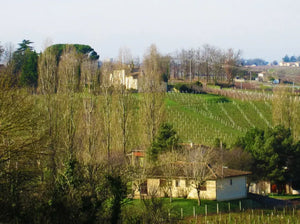Blog » Bordeaux
-
Rediscovered Bordeaux: Chateau Le Puy
In college, a Médoc was my epiphany red wine moment. In just one sniff, my growing fascination with wine shifted from California to France. Regrettably, those thrilling experiences via Bordeaux don't really come around anymore. The point-chasing, over-extracted, over-oaked, ripe-beyond-recognition style set in motion in the mid-80s has changed the region for the worse, and the pendulum has to swing back. Yet, terroir-driven producers do still exist.
Situated between Pomerol and Saint Emilion on the second-highest point along the Gironde estuary, Chateau Le Puy is a Bordeaux estate rooted in sensibilities more commonly found in Burgundy. The wines' finesse, transparency of place, and approachability are worlds apart from the stylistic norm in this revered region.These vines have been farmed free of chemicals since 1610, and today, full biodynamic practices are employed, with work done by horse. The estate's plantings include 85% Merlot, 7% Cabernet Franc, 6% Cabernet Sauvignon, and small percentages of Malbec and Carménère on an amalgamation of red clay, silex, and limestone soils.In addition to organic and biodynamic farming, their fermentation and élevage methods are also considered uncommon. Infusion and semi-carbonic methods limit the extraction of tannins, providing soft texture and bright, open-knit fruit out of the gate. Aging in large foudre preserves all of that backbone of mineral tension, bringing a freshness missing from the surrounding chateaux.The WinesDuc des Nauves sits at the lowest elevation on the property on a sandy limestone parcel and is fermented and aged exclusively in cement. It's one of the best values available in Bordeaux.Emilien is the main wine of the chateau. Its personality shows silken tannins and elegance that neighboring Pomerol is revered for. Aged in century-old foudres and neutral 228-liter Bordeaux barrels.Bartélemy comes from "Les Rocs," a parcel of old vines planted on deep limestone. Its structure, saturating texture, and persistence rival those under the region's famous classifications of 1855 and 1955. Aged in 228-liter barrels (Less than 10% new). -
The Real St-Émilion Deal: Chateau Tertre de La Mouleyre
Chateau Tertre de La Mouleyre is not your typical Grand Cru Bordeaux, but it is the real Saint-Emilion deal. The 2016 vintage left me so in awe that I took every case allocated to California, with only 350 cases produced annually. Those are long gone, but I've gone deep on every release since then.
To place Chateau Tertre de la Mouleyre in the garagiste category would be a mistake. While they don't have the same typicity as grand chateaux in the classified growths, they marry the two philosophies for the perfect storm: Bordeaux ready to drink upon release with immaculate construction.
The blend is 80% Merlot and 20% Cabernet Franc from 50-year-old vines. 35% ages in large neutral cuve and 65% in new French oak barrels. I'm immediately inclined to describe this gem as old school and traditional, but its warmth and charm afforded by today's climate carry a level of finesse and complexity that is pure Grand Cru.
Tertre de la Mouleyre is named after the windmill atop the clay and limestone slope in St-Étienne de Lisse. From a young age, Eric Jeanneteau helped his grandfather in the vines, and his interest never diverged for a moment. After three degrees in viticulture and stints at grand chateaux, Eric returned home to implement a full organic regimen to his family's vines.
.svg?v=162776257677185172071724397232)




